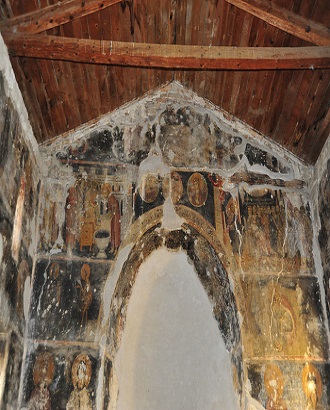
Museum - the refectory
The refectory contains in situ frescoes, archaeological remains and a mosaic.
Important works of Byzantine wall-painting were produced in the thirteenth and fourteenth centuries in the monastery at Apollonia. The style of painting shows local and Byzantine, and also Western, influence. A leaning towards classical Greek models is more obvious in the late thirteenth or early fourteenth century frescoes in the refectory of the Apollonia monastery, remarkable for their high level of artistic achievement (for example, the Prayer in Gethsemane).
The extensive remains of the painted decoration of the triconch refectories preserve painted decoration dating from the Byzantine period, and the refectory at Apollonia is the most important, from this point of view, after the refectory of the monastery on Patmos. The decoration is divided into three zones, as is frequently the case in churches. The bottom zone is occupied by an array of full-length saints, with scenes drawn from the gospels in the top zone, while the middle zone has scenes on the east side and medallions with saints on the north and south (no wall-paintings are preserved on the westside). Most of the scenes are related to readings or hymns for Lent. Only fragments of wallpainting are preserved in the katholikon of the monastery, a cross in square church with a large dome. On the east wall of the exonarthex is a wallpainting, preserved in very poor condition, of Michael VIII Palaeologos, with the appellation New Constantine, his son Andronikos II, his grandson Michael IX, and members of the imperial family, offering a model of the church to the Virgin. The representation has been dated to 1281/2.
Inscription on the wall:
([Michael, in Christ God faithful king] and e[mperor of the Romans], new Constantine, Komnenos, Doukas, Angelos, Palaeologos, the true lover of Christ and monasticism). Constantine the Great constituted one of the most enduring historical archetypes. As the first leader of the new Christian world (equal to the Apostles), he developed into the rolemodel proper of the Christian military ruler who defeats the enemies through faith and the grace of God. For the Byzantines, Constantine was the unquestionable model for the ideal Byzantine emperor. It is manifested through the inscription accompanying the imperial group portrait of the exonarthex at the Church of the Virgin which represents, among others, emperor Michael VIII Palaiologos and his son co emperor Andronicos II. The commission of the portrait is associated with the battle of Berat in 1281 and the spectacular victory gained by the Byzantine emperor over the self-proclaimed king of Albania (1272), Charles Anjou I.